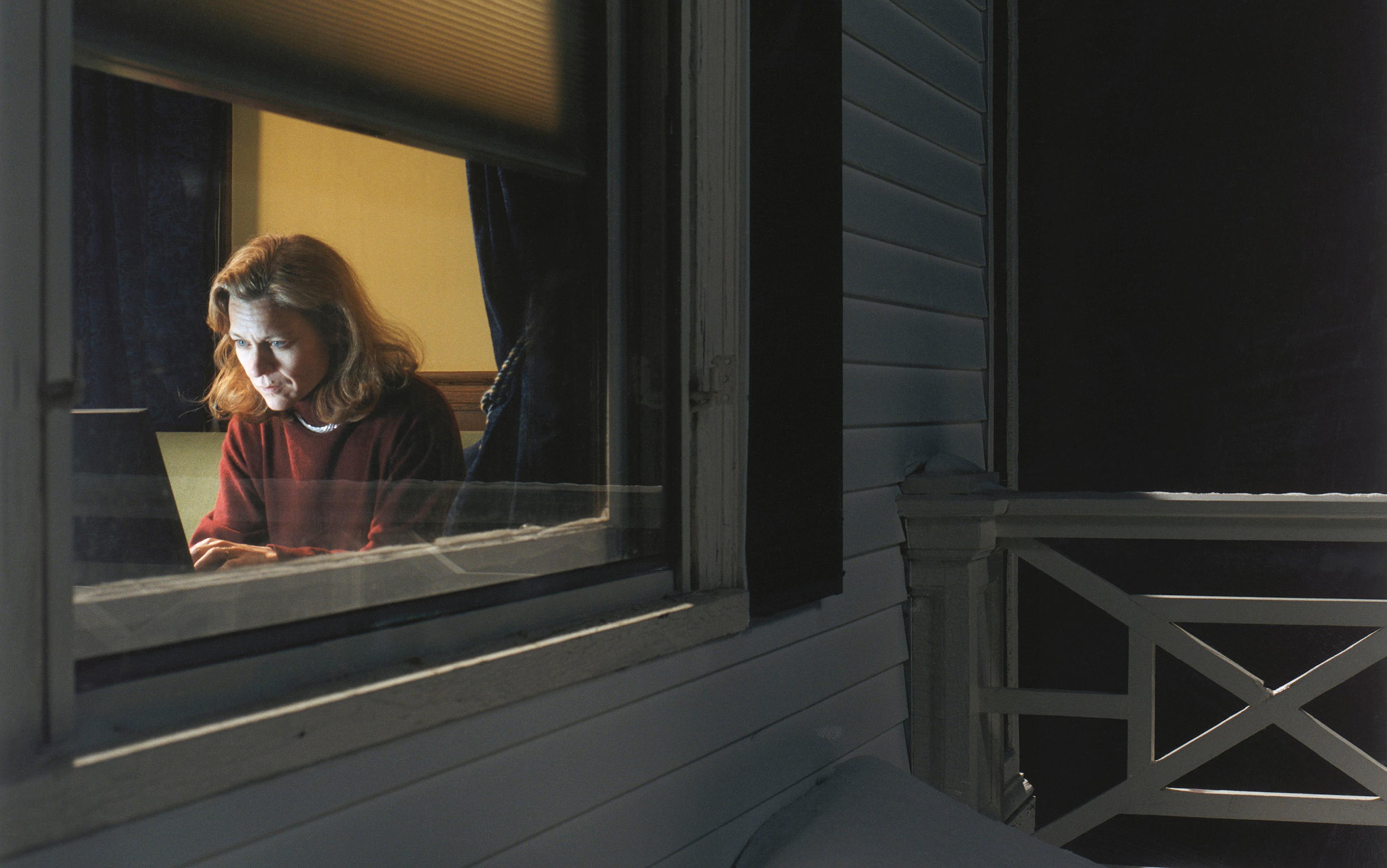After decades of research, there is still no clearly articulated scientific consensus on what sleep is or why it exists. Yet whenever sleep comes up as a topic of discussion, it is quickly reduced to its necessity and importance. Popular media remind us of what can, and will, go wrong if we do not sleep enough, and serve up some handy tips on how to overcome insomnia. Discussed exclusively in utilitarian terms, we are force-fed the idea that sleep exists solely for our immediate benefit. Is this really all we ever want to know about a third of our existence? Sleep is perhaps the biggest blind spot, or the longest blind stretch, if you will, of our life. Naturally, the health and societal implications of sleep are huge: from technogenic disasters caused by tiredness, to sleep deprivation as a form of torture or weapon of war, and to sleep disorders, some of which inflict so much suffering that they compete with chronic pain. However, in my opinion, to say sleep is important is to miss the point entirely. Sleep is the single most bizarre experience that happens to all of us, against our will, every day.
The disconnect between old questions about sleep that have remained open for centuries and new, increasingly sophisticated technologies applied to solve them is ever growing. The predominant view is that sleep provides some sort of restoration for the brain or the body: what goes awry – out of balance – in waking is almost magically recalibrated by sleep. At the centre of this narrative is the individual-who-sleeps, a lone castaway, locked in a permanent, inexorable cycle of sleeping and waking, without hope of breaking free (except in death). From the moment of opening one’s eyes, the clock starts ticking, and there is a price to pay for every minute of wakeful time, measured precisely in proportion to the transgression of staying awake. Like a snake eating its own tail, waking and sleep consume each other in an endless cycle, without beginning or end. There is no mercy, and lack of sleep can be paid back only by sleep. The image of burning a candle at both ends endures.
Despite vast technological advances in recent years, exponential growth in our understanding of nature and the cosmos, and major breakthroughs in biology and medicine, there is still no unified theory of sleep. I find myself pondering whether it is time to step back and seek a different angle.
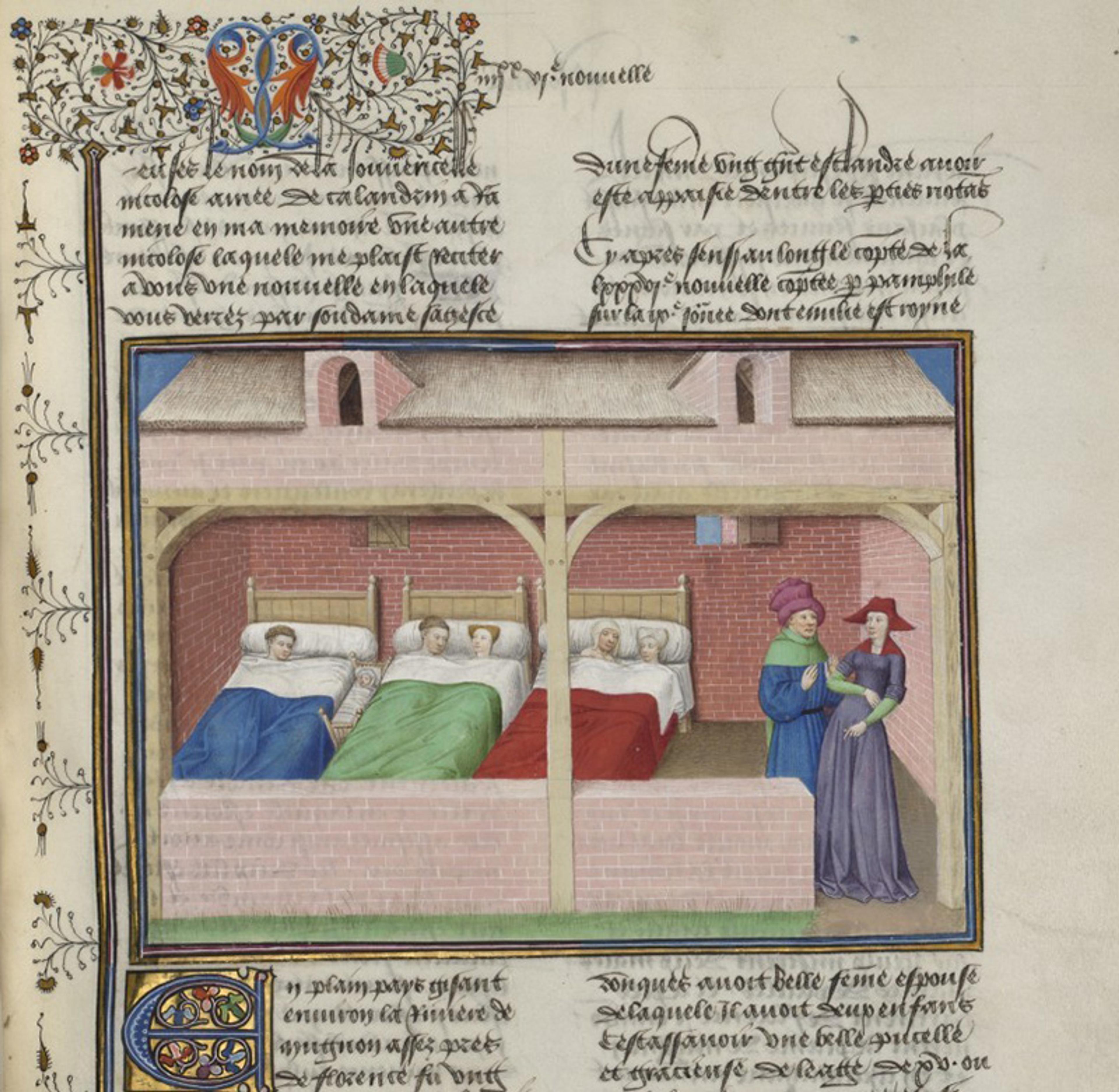
Illustration from a manuscript of The Decameron by Giovanni Boccaccio, translated by Laurent de Premierfait, circa the 15th century. Courtesy the BnF, Paris
I propose taking an alien perspective on sleep. Imagine our planet Earth from space, and try to picture all the organisms inhabiting it these days – plants, fungi, bacteria, insects, mammals, birds, fish – a sphere teeming with life. If you wanted to have some sort of measurement of all this biological activity – think of these creatures running, swimming, flying, building nests or digging burrows, migrating, hunting, eating, drinking, mating, caring for the young, even playing. Earth behaving in countless ways, nature in action, existence through movement, at different spatial and temporal scales. Trophic chains and multilayered networks of organisms interacting, exchanging energy, matter and information, co-existing and co-evolving. Strikingly, the last thing in this picture that would come to mind – if at all – is sleep. Let’s try to overcome this and, in your mind’s eye, make sleep visible – revealed as a sort of negative image of activity, where action is hidden and stillness is all you can see. A new view will emerge, one that is just as rich and dynamic. We live on a half-asleep planet where, speaking of our species alone, at any given time close to 2 billion people may be asleep.
Why is sleep, which literally occurs daily on a planetary scale, so often taken for granted, and not only by most people but even by scientists? Perhaps because its essence, its key property, is to be elusive, out of sight? Sleep is about being invisible, private, not attracting attention, our secret, vegetal life, a pure existence outside the maelstrom of interaction. Not surprisingly, echoing Aristotle’s view of it as ‘a privation of waking’, sleep is typically defined by what it is not, rather than what it is. It is not moving, not acting, not responding, being disconnected from the world, doing nothing, at least from the observer’s perspective. When any organism sleeps, it takes a kind of leave of absence: it stops interacting with the environment, withdraws from action, and also gives space to others. Sleep, nightmares apart, is the only time when we are at peace with ourselves, forgetting pain and suffering, and the world outside, as we leave it alone to respite from us. A blessing for both the sleeping individual and for planet Earth.
Defining sleep was never an exact science. The 19th-century Scottish physician and philosopher Robert MacNish thought of sleep as ‘the intermediate state between wakefulness and death: wakefulness being regarded as the active state of all animal and intellectual functions, and death as that of their total suspension.’ Similarly, according to the physiologist Alexander Philips Wilson Philip writing in 1834, sleep is a temporary cessation of vital functions, while death is simply a permanent one: ‘The death of old age … is literally the last sleep, uncharacterised by any peculiarity.’ One wonders if this view is now passé, or still taken seriously. Otherwise, why would gravestone inscriptions so often use the euphemism of sleep to describe death? ‘She fell asleep, aged 84.’
While it is natural to think that responsiveness is greatly attenuated during sleep, it is not strictly true
In longevity science, one idea is that ageing and death have evolutionary advantages that outweigh the alleged benefits of immortality for individuals. According to this idea, sometimes referred to as altruistic ageing or, more technically, programmed senescence, death refreshes the population, prevents resource depletion and improves species adaptation – all for the benefit of the group and ultimately for the species rather than individuals. Curiously, some of these arguments can be applied to sleep. Just imagine the influence of sleep at the level of any ecosystem, beyond individual organisms. Cycles of sleep and wakefulness shape the community structure, influence dependencies between species, determine how interactions between organisms vary in time and space, change the environment, create temporal niches, minimise competition for resources, and more. Viewed from this perspective, it is easy to see that sleep has an important supra-individual level, affecting the dynamics and stability of ecosystems, and therefore representing an important driving force for the evolutionary process. One intriguing implication of this insight is that individuals do not have to be conscious of why they sleep in a particular way, for sleep is not, or not only, for our immediate benefit. To put it differently – sleep is of individual organisms, but ultimately it is for future generations, for the community, for the species.
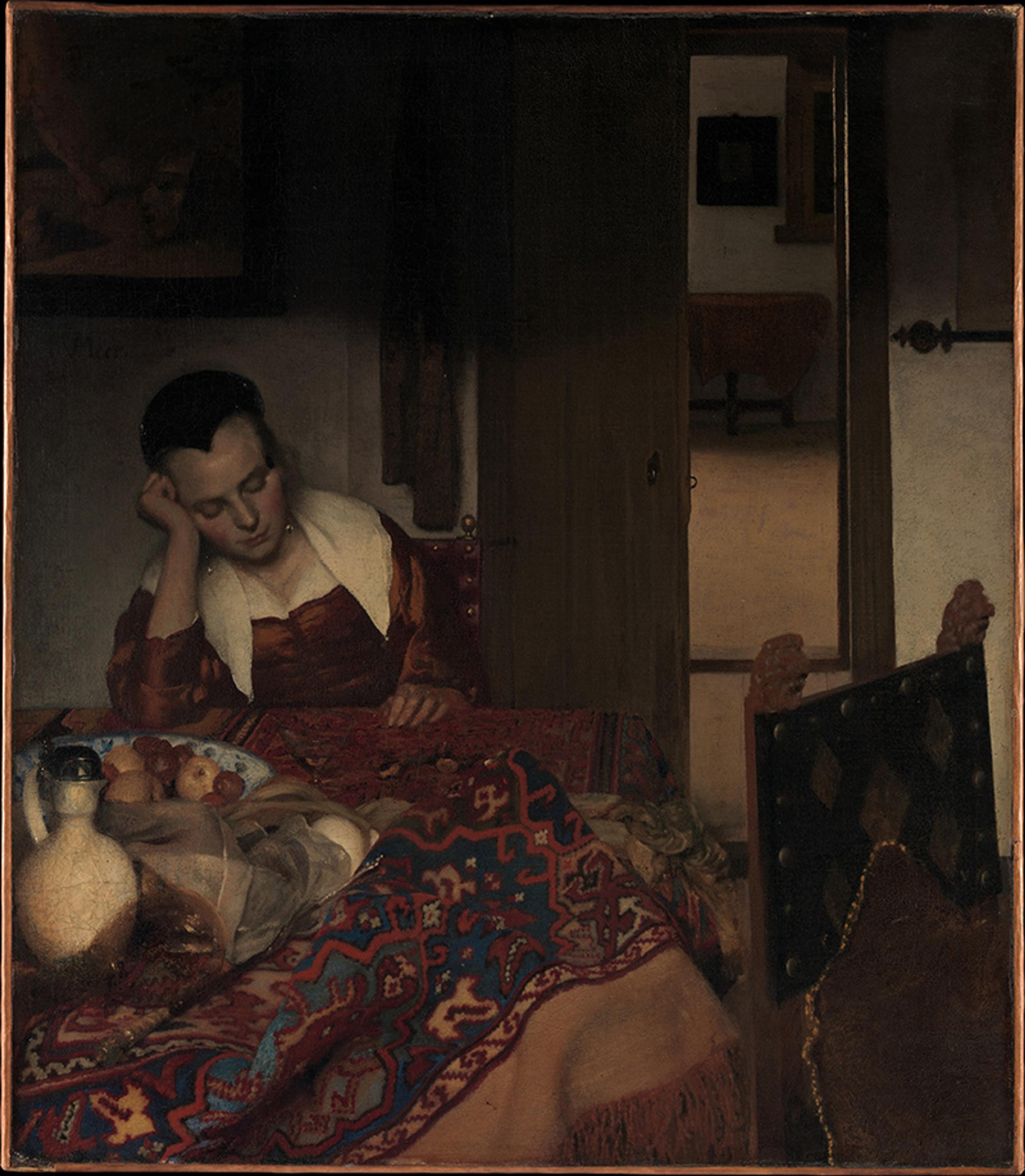
A Maid Asleep (c1656-57) by Johannes Vermeer. Courtesy the Met Museum, New York
Still, our classical criteria for defining sleep are purely individual-centric. They include immobility or quiescence, a typical (usually horizontal) body posture, a specific sleeping site, an elevated threshold for arousal/reactivity and rapid state reversibility. These ideas resonate with early attempts to define waking and sleep such as the one offered by one Dr Stancliffe back in 1810, when he declared:
That state in which our perceptions are distinct, and in which we direct the muscles of voluntary action according to the will, is that in which we are awake: that in which we are neither sensible (of external objects) nor capable of producing motion by the will is called sleep.
Using modern terminology, sleep is associated with an elevated ‘arousal threshold’ that, to put it differently, refers to a relative disconnection from our surroundings, those ‘external objects’ around us. One way to measure arousal threshold is to apply a stimulus of increasing intensity to detect the level at which a behavioural response occurs. While it is natural to think that responsiveness is greatly attenuated during sleep, it is not strictly true. The nervous system is in fact highly reactive even in states typically considered associated with unresponsiveness, although it is not clear to what end. For example, recent studies describe clear-cut brain responses to sensory stimuli not only during sleep but even during deep anaesthesia, without any overt reaction and with no memory on waking of the encounter with the stimulus. One cannot help but consider the uncomfortable possibility that we may in fact experience excruciating pain while anaesthetised for a surgical procedure, which we somehow erase on waking.
On the other hand, while awake, we spend a considerable amount of time either mind-wandering, disconnected from our surroundings, or in a state of heightened connectedness and hyper-responsiveness, often to many things at once. This may be a radical departure from what it was like to be awake for our ancestors, who were probably mindful of only one thing at a time, and only if it was truly important and real, worthwhile experiencing. According to one theory, it is in the organism’s best interest to remain ignorant, and sleep exists to prevent us from acquiring unnecessary knowledge. This no longer applies to us. A striking feature of our modern wakefulness is not only that we attend to and learn what we do not really need, at the expense of sleep, but also that, while awake, we are often dealing with mere appearances or representations of reality – a point made by Guy Debord in La Société du spectacle (1967) – lacking authenticity in perception.
To push this even further, it is useful to consider how the defining criteria for wakefulness and sleep can be applied in other contexts – for example, to plants, or to seemingly perpetually active organs in our body, such as the heart and lungs. Do organs rest, or even sleep? What would that even mean? An original objection to the idea that all organs in the body carry out uninterrupted function was made by the aforementioned Philip in a creative, if somewhat dubious, manner: ‘as the systole occupies only about a third part of the time occupied by the diastole, it follows that the muscular fibres of the heart are 16 out of the 24 hours in a state of inaction … The muscles of respiration, we need not say, have the same proportion of rest.’ We know now that it is more interesting, and complicated, than that. For example, the physiological mechanisms of the rhythmic electrical discharge of the heart share fundamental similarities with sleep oscillations in the brain, while breathing can even ‘entrain’ brain waves during sleep.
Take another example of sleep and anaesthesia in plants. One of the first mentions is attributed to Carl Linnaeus in the 18th century, who used the criteria of being able to move or sense to classify living from non-living and plants from animals. The notion that plants do not move is, of course, wrong, they just move slowly and in a somewhat peculiar manner. Furthermore, although plants don’t have nervous systems in a traditional sense, it does not imply that they don’t share some mechanisms for cellular signalling and communications with animals, even including action potentials, similar to those neurons used to exchange signals in the brain. The idea of the floral clock, building on the daily regularity of ‘sleep’ in plants, or ‘somnus plantarum’, as Linnaeus called it, anticipated the emergence, and triumph, of chronobiology – the study of circadian rhythms, molecular mechanisms of which earned Jeffrey Hall, Michael Rosbash and Michael Young the 2017 Nobel Prize in Physiology and Medicine.
It is only a question of time before it’s considered ethical to spray lawns with ether before mowing
Although mostly known for his theory of evolution, Charles Darwin dedicated significant time and effort to studying plant behaviour. In his book The Power of Movement in Plants (1880), co-authored with his son Francis, Darwin discusses various tropisms (growth in a specific direction) and so-called nastic movements in plants, for example nyctinasty – which includes the opening and closing of flowers. In their book, the Darwins remark upfront: ‘Hardly any one supposes that there is any real analogy between the sleep of animals and that of plants, whether of leaves or flowers,’ yet they then continue using sleep terminology when describing plant behaviour for the remainder of the book.
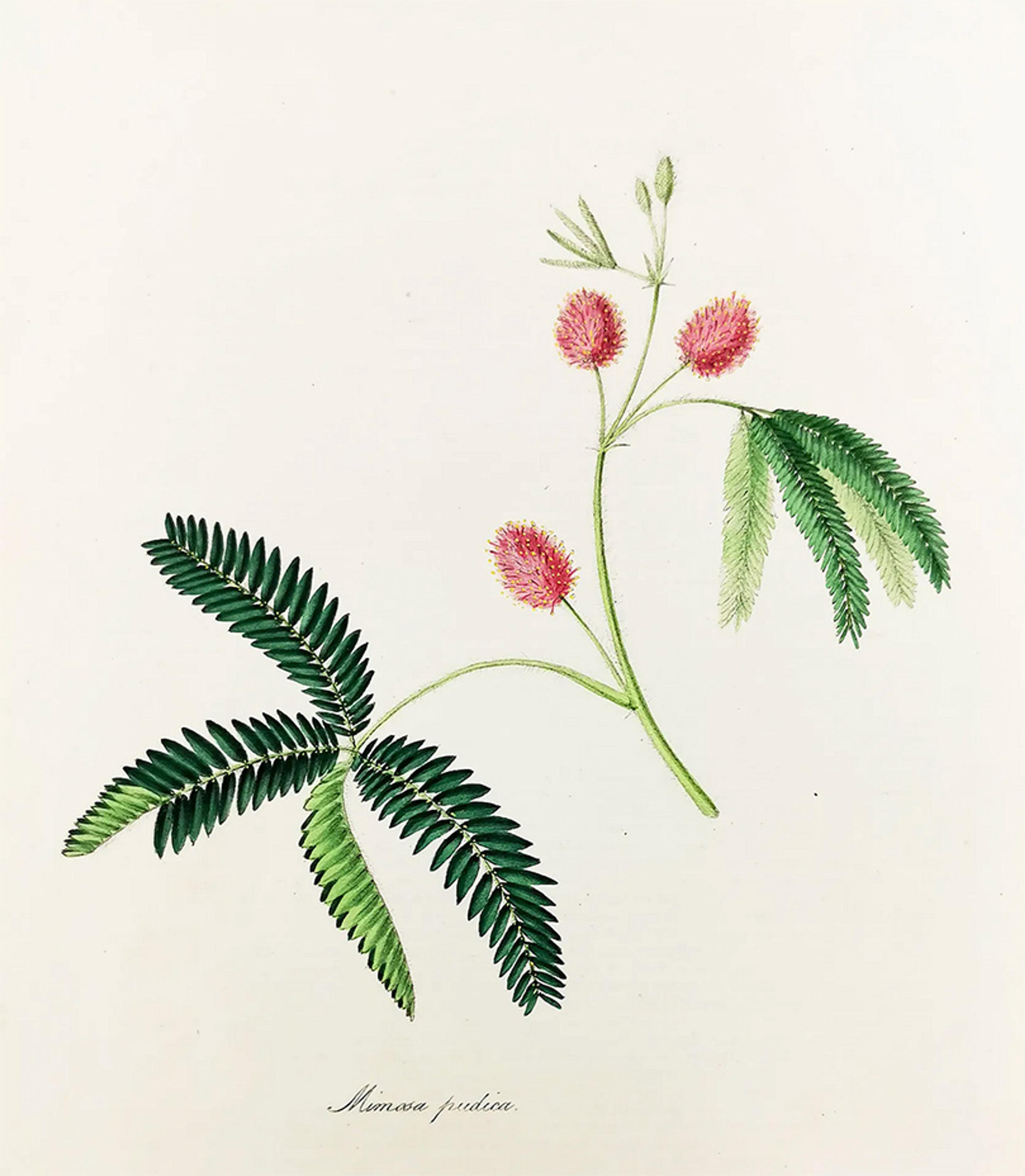
From Plantae Utiliores or Illustrations of Useful Plants (1840) by Mary Ann Burnett. Public domain
Whether plants can be awake or asleep is still a disputed question, but it was noted early on that plants can be anesthetised. According to the 19th-century French physiologist Claude Bernard ‘what is alive must sense and can be anesthetised, the rest is dead’. He observed that applying ether to the ‘sensitive’ Mimosa pudica plant resulted in a temporarily reduced ability to move in response to touch, similar to how animals respond to an application of anaesthetic. It is probably only a question of time before it will be considered an ethical imperative to administer local anaesthesia to fruit trees before pruning them or even spraying lawns with ether before mowing. But, in any case, further work is needed to determine why and to what extent anaesthesia renders plants unresponsive or, more generally, whether plant movement is a purposeful behaviour, associated with awareness of some kind, or something akin to sleepwalking.
In humans, there is a peculiar range of sleep disorders called parasomnias, or disorders of abnormal behaviours during sleep, of which sleepwalking, or somnambulism, night terrors and confusional arousals are among the most common. The exact types of parasomnias are distinguished by when in the night and from what sleep stage they arise. Some parasomnias are more frequent in childhood, and some, such as REM behaviour disorder, serve as a fairly accurate predictor of Parkinson’s disease. While the actions performed by parasomniacs are often harmless, some may involve elaborate and dangerous activity – ranging from self-injury or harm to bed partners to, in some cases, rape and even murder.
To deal with such cases, a new subspecialty has recently emerged in the intersection between sleep science and law – forensic sleep medicine. The so-called M’Naghten rule is sometimes invoked in cases when the defendant claims that the crime was committed involuntarily, while asleep and lacking awareness. This legal framework is named after Daniel M’Naghten, a Scottish wood turner, who, back in 1843, attempted to assassinate the British prime minister as a result of paranoid delusions that the Tory government was conspiring against him. M’Naghten did not know, or was unable to comprehend, that what he was doing was wrong – the very nature of a delusion, and this is why he was acquitted as insane (in cases of insane automatisms, individuals may still be found guilty and confined to a psychiatric facility). A sleepwalking episode would, instead, be an example of a non-insane automatism, and if a crime is committed during somnambulism, the defendant would also likely not be found guilty.
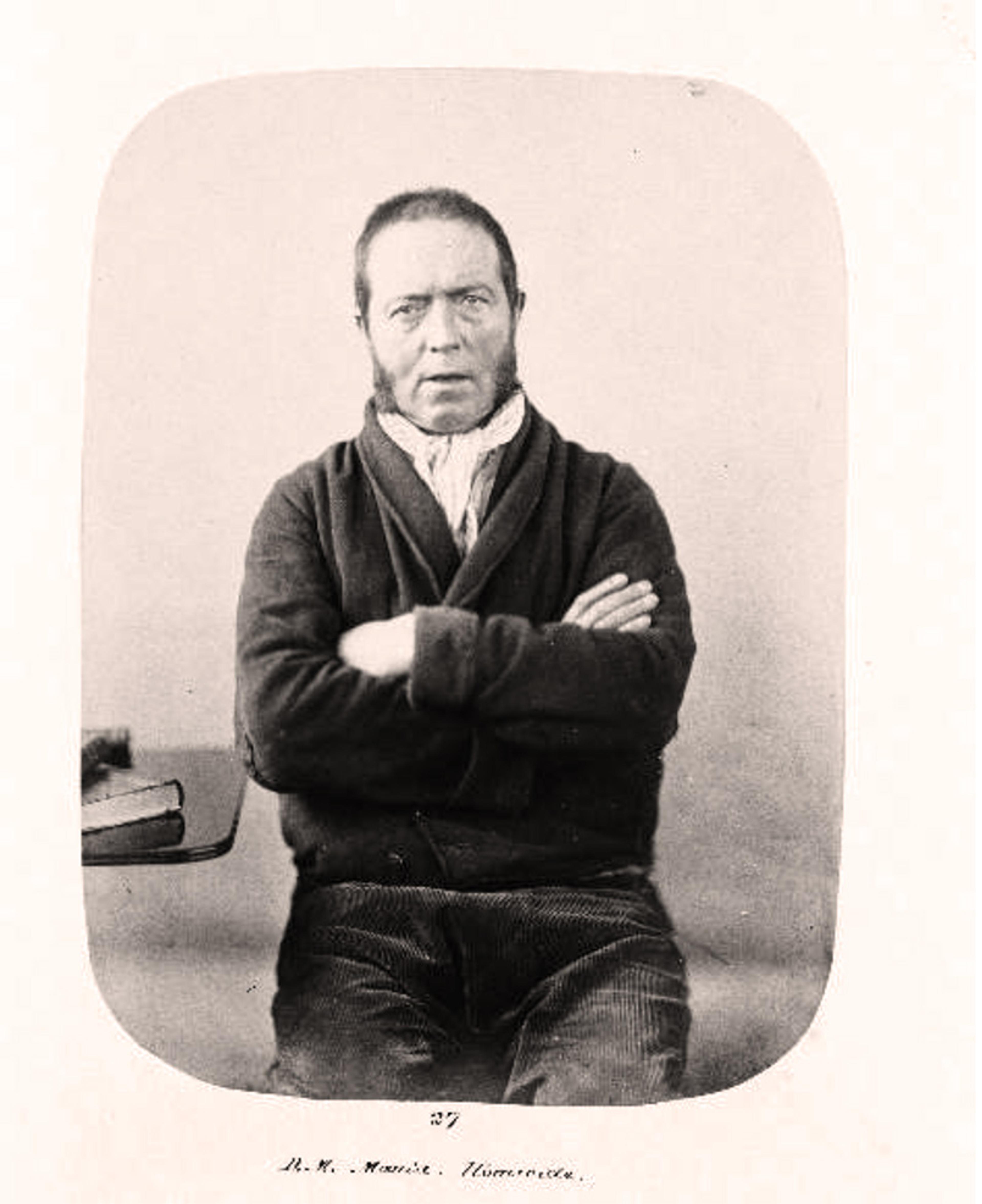
Daniel M’Naghten, c1856. Courtesy Bethlem Hospital Archives/Museum of the Mind
An important conundrum for the legal system emerges when an accident or a crime is associated with an altered state of sleep (or waking) induced by alcohol or even prescribed medicines, such as hypnotics. At any rate, such conditions represent an extremely interesting challenge not only for lawyers, but also for our scientific understanding of sleep, where responses to, or interactions with, the outside world must be, by traditional definition, suspended.
What is going on inside the sleeping brain during our typical night, and what can we learn from studying it to explain changes in our responsiveness to the world outside, or an occurrence of mixed states such as somnambulism, sleep paralysis, lucid dreaming or out-of-body experiences? Important early insights were provided by the work of the American scientist, lawyer and entrepreneur Alfred Lee Loomis, who in the late 1930s published several articles on brain rhythms during sleep.
The motivation for his work was ‘the development of a type of amplifier system specifically designed to faithfully record the unusual types of potential occurring during sleep’ and ‘correlate these with movements, with dreams, and with external stimuli applied to the sleeping subject’. In addition to describing distinct sleep states, including what later came to be known as rapid-eye movement (REM) or paradoxical sleep, Loomis describes several types of state-specific brain oscillations, including slow waves – electrical events occurring at a frequency of 1-2 Hz (somewhat slower or faster according to different authors), and considered to be a fundamentally important type of brain activity during sleep. Slow waves dominating the non-REM phase of sleep correspond to generalised brief pauses in neuronal electrical discharges, ‘blinks’ as it were in neural activity. They don’t occur at the same rate throughout the night, and their occurrence correlates with the elevated arousal threshold, already mentioned above.
In 1885, Hall’s Journal of Health said that a curve reflecting a ‘decisive sign of awakened consciousness’ in response to auditory stimulation shows a characteristic progression across the night, indicating reduced arousability in the first half of sleep. A similar dynamics was observed in 1937, further noting the relationship between ‘sleep depth’ and electroencephalogram (EEG) slow waves. Caution is warranted with the metaphor of ‘sleep depth’, which is widely used to denote non-REM sleep, but can be misleading for several reasons. For example, sleep can be as ‘deep’ in REM sleep, if measured by the arousal threshold, as during non-REM sleep, and more recent work suggests a rather poor correlation between objectively measured ‘sleep depth’ and how a sleeping subject perceives it ‘subjectively’. Once again, the authenticity of sleep as lived experience is too often readily replaced by arbitrary metrics and questionable metaphors, reducing sleeping itself to obtaining, at any cost, ‘measurable good sleep’.
The other intriguing observation made more recently was that, while EEG slow waves during sleep correlate with reduced arousability, these very same slow waves can easily be triggered by stimuli from outside. One way to illustrate this: if I knock on the door of your bedroom while you sleep, and if you were wearing EEG electrodes, I would likely observe ‘evoked’ slow waves faithfully following the auditory sounds, while the perception remains subliminal. The immediate and highly sought-after application of this property of sleep is the development of brain stimulation technologies for sleep enhancement, or augmentation, with the purpose of improving sleep, especially in cases when it is insufficient or disrupted, and even as a countermeasure for age-related dementias and other neurodegenerative disorders. Scientists strive to build what they call ‘closed-loop’ stimulation devices that monitor brain activity and apply stimuli, such as direct brain-stimulation pulses, or auditory clicks, at a specific phase of spontaneous slow waves, for enhanced activity. The idea is somewhat counterintuitive yet evidence is strong that, by providing a subtle push at the right time, brain activity can be effectively entrained and slow-wave activity enhanced, emulating the condition of the early part of the night, when slow waves are naturally the strongest.
Perhaps we are never fully awake or fully asleep, but always somewhere on the spectrum
The interest in non-pharmacological manipulation of sleep was growing as a result of a somewhat limited success in pharmacological sleep promotion. Obviously, sleep was among the very first targets of medicinal chemistry around the middle of the previous century. Leaving aside the popularity of opium, that substance possessing virtus dormitiva in Molière’s play The Imaginary Invalid (1673), the first breakthrough came with the synthesis of benzodiazepines by Leo Sternbach – a Polish scientist born in the Austro-Hungarian empire in 1908, who obtained a degree in pharmacy at the University of Lviv, now in Ukraine. Benzodiazepines became among the most often prescribed medications ever, with billions of doses of Valium – named from Latin valere (‘to be healthy’) – prescribed every year, and more short-acting analogues with fewer side-effects are still widely used today.
Benzodiazepines and related compounds typically work as so-called ‘allosteric modulators’ of a specific type of inhibitory receptors in the brain, normally stimulated by a neurotransmitter called GABA. How exactly this translates in sedation and occurrence of sleep is difficult to determine, given how widely GABA is found across the brain, but great progress has been made to delineate its specific sites of action and corresponding cellular mechanisms. What is remarkable is that, if you look closely at the brain waves during sleep induced by conventional hypnotics, it does not fully resemble ‘deep’ sleep, but instead slow waves on the EEG are reduced. More recent developments in pharmacological manipulations of sleep target another system in the brain, centred on orexin (also called hypocretin), a hypothalamic peptide, whose link with narcolepsy, established in the late 1990s, was transformative for the field. Antagonising orexin receptors is thought to depress the brain circuitry that keeps us awake, promoting slow waves and making sleep more ‘intense’ and, arguably, restorative.
The observation that slow waves are especially prominent relatively early in the sleep period was foundational for one of the most influential theoretical frameworks in sleep research – the concept of sleep homeostasis. Homeostasis, more generally, refers to the ability of a system to maintain a dynamic balance of its state by regulating its parameters. ‘Somehow the unstable stuff of which we are composed has learned the trick of maintaining stability,’ as Walter Cannon put it in The Wisdom of the Body (1932), building on the foundation laid by the aforementioned Bernard in the 19th century, who drew a distinction between ‘milieu cosmique’ – the external environment surrounding an organism – and the ‘milieu intérieur’, or internal environment, which must be kept constant for living organisms. Sleep homeostasis in this context, proposed by the Swiss sleep researcher Alexander Borbély, describes the observation that staying awake is associated with the build-up of sleep drive, or sleep pressure, which needs to be compensated, by sleeping more, or more intensely, to restore the balance. Hence – homeostasis.
Early literature such as Hall’s Journal of Health in the 1850s abounds with observations that the ‘amount of repose’ should be ‘proportioned to the exertion of the previous day’ as ‘the more we work, the more we study, the more sleep we require’, and is replete with descriptions of the horrors that follow if the sleep need is not satisfied: ‘if we attempt to rob the body of its requisite amount, debility of body, madness of mind, or premature death, will always result’. In turn, it was noted that ‘Excess of sleep is seldom injurious. It weakens the whole system, renders one torpid, dull and nearly stupid …’ , yet it was recommended as the recipe for not falling asleep during inappropriate times, for example during a service in the church: ‘we know of no available method of keeping wide-awake, within the sound of a dull sermon than this, take a nap before you go’, and is consistent with more recent work suggesting that obtaining extra sleep may in fact help to deal with subsequent sleep deprivation, called ‘banking sleep’.
What happens in the brain when we are sleep-deprived has been a focus of intense research for decades, including in my laboratory at the University of Oxford. It was noted that slow waves – the EEG potentials reflecting sleep – are also fairly common during wakefulness, especially during states such as mind wandering or when you are tired and sleep-deprived. This possibly reflects the state of being not fully awake, a state that often leads to errors in judgment or loss of attention. This notion supported the idea of ‘local sleep’ – the suggestion that sleep is not a property of the whole brain, but that sleeping and waking parts of the brain can coexist. Could someone apparently awake be partly asleep, and vice versa? According to our current understanding, it is highly likely that this happens not only in somnambulism or when you are experiencing sleep terrors or being abducted by aliens, but in normal life too. Perhaps we are never fully awake or fully asleep, but always somewhere on the spectrum.
Philosophers refer to such a scenario as a vagueness problem, arising when a process or a phenomenon cannot be precisely defined. Some sleep scientists acknowledge the inadequacy of our current method for distinguishing waking from sleep, and devote considerable time and effort to addressing it, especially when it has important clinical implications. For example, if you are an insomniac or simply could not fall asleep last night, it may have been because parts of your brain were overactive. And when you feel tired, it is possible that parts of your brain are already asleep. As no clear boundaries between wake and sleep exist, finding a link between a specific state of vigilance and consciousness is a difficult task. Dreaming is a good example, as it has been established that we can dream not only during REM sleep, characterised by intense brain activity, but also during more quiescent non-REM sleep.
The idea of ‘partial insomnium’, when ‘certain faculties of the mind … may fall asleep while others wake’ was first proposed back in the 19th century, but the idea remained unexplored for decades. Writing in 1897, Maria Manasseina, a Russian scientist who pioneered sleep-deprivation experiments, said that ‘sleep is not an absolute arrest of cerebral activity. The brain remains partially active, only sleeping in so far as it is the anatomical basis of full consciousness.’ In turn, Giuseppe Moruzzi, a prominent Italian neurophysiologist from Pisa, noted in 1972 that ‘sleep concerns primarily not the whole cerebrum, nor even the entire neocortex, but only those neurons or synapses … which during wakefulness are responsible for, or related to, the brain functions concerned with conscious behaviour.’
Sleep is there not simply for recovery or rest, but could be, in fact, our default state of being
Towards the end of the 20th century, these ideas were taken forward and developed into a comprehensive theory by James Krueger, an American scientist, and Ferenc Obál, a Hungarian neurophysiologist, both interested in discovering links between sleep regulation, neuropeptides and the immune system. Some of their ideas were inspired, in part, by the theory of neural Darwinism put forward by Gerald Edelman, a renowned American immunologist and Nobel Prize winner. The theory, in a nutshell, refers to a survival or persistence of only those neural connections in the brain, initially abundant, that were used effectively to support brain functions. According to this idea, unused connections weaken and eventually wither altogether, leaving more space and resources to those connections that matter, and allowing them to survive, hence Darwinism (there are, however, some obvious differences from Darwin’s theory).
The use-dependency of highly plastic brain networks formation and development fuelled the idea proposed by Krueger and Obál, who placed the emphasis on ‘neuronal groups’, as units of sleep that operate semi-independently and initiate sleep as a result of prior activity. This idea provided a much-needed theoretical foundation for the early insights suggesting a link between sleep and neural plasticity – the capacity of brain neurons to change as a result of experience. The British Medical Journal from 1899 cites a Dr Ira Van Giessen, writing:
By retraction of its tentacles, [the nerve cell] is capable of throwing itself out of circuit; by expansion of them again the circuit is restored … this retraction and expansion of the arm of the nerve cell, in groups, systems, and communities of brain cells, drawing it in or out of the circuit of transmission of nervous impulse, is the final unveiling of the secret of a whole host of mental phenomena which hitherto have seemed mysterious to the last degree.
For decades, the idea of neural plasticity had remained one of the cornerstones of modern neuroscience, and while many ‘mental phenomena’ are still far from being well understood, the link between synaptic malleability and sleep remains at the forefront of research across many labs worldwide.
The idea of ‘local sleep’ regulation was also intertwined with the early insights, recently attracting increasing attention, that sleep represents a default, primal state of brain networks, and even of the whole organism. One can, for example, emulate ‘sleep’ in the lab Petri dish, by growing brain neurons completely taken out of the context of the brain. Scientists find that neurons are not only perfectly able to survive on their own, but they also find strength to gradually rebuild synaptic contacts. When this new-born network emerges, it starts generating highly synchronised regular patterns of electrical discharge, not dissimilar to sleep, anaesthesia or a peculiar type of brain activity called ‘tracé discontinu’ found in preterm infants. The regular ‘spontaneous’ bursts of neuronal activity, often accompanied with twitches, are typical for some forms of sleep. There is a website called Twitchsleep, where one can find numerous examples of animals twitching during sleep – from humans and dogs to exotic creatures, such as platypus or even aardvarks. According to this idea, which I find highly attractive, sleep is there not simply for recovery or rest, but could be, in fact, our default state of being. Perhaps we evolved to spend most of our lives asleep, in a plant-like vegetal state, waking only when necessary to satisfy essential, vital needs, and then regressing back to our ancestral, primal condition.
If at this point you are feeling less certain about what sleep actually is, what it is for, and how unsatisfactory the perspective of sleep as being merely ‘important’ is, then I am making good progress toward my objective. But let me go slightly further, and explore the variety of sleep phenotypes among animals beyond humans. The progress of sleep research is hard to imagine without investigation into how other animals sleep. The field of sleep phylogeny was pioneered by Irene Tobler, a Swiss sleep researcher who described sleep in many different species. From cockroaches and scorpions to elephants and giraffes, the list grew impressively, and in more recent years camels, sloths, hydra, jellyfish, bearded dragons, octopuses, penguins and many other exotic and more familiar creatures have been added. Because of the wide variety between species, I scarcely know where to start when describing the striking range of sleep habits among animals, but I would like to make a few points.
First, we are yet to find animals that don’t sleep at all; however, in many cases, applying human-centric criteria for defining sleep really pushes the limits. For example, immobility or responsiveness may be difficult to apply to thousands of species of sessile animals, which barely move in a lifetime. What constitutes sleep for a sea anemone, coral or a mussel? Perhaps they sleep in their own way, but we need to agree criteria to assess that.
Secondly, the forms of sleep among animals span a vast range of possibilities – from many regular hours of continuous slumber, to highly fragmented and idiosyncratic patterns, from being nocturnal, diurnal or crepuscular, to having no preference when to be awake or asleep altogether. Some birds may sleep in flight, while cetaceans never sleep with both halves of the brain at the same time. Seals do the same in water, but seamlessly engage in ‘global’ sleep on land. Elephant seals slowly submerge upon falling asleep, producing a ‘falling leaf’ pattern as they reach the deepest stages of sleep and the deepest waters of their dive, not resurfacing for dozens of minutes. Reindeer continue ruminating while seemingly asleep, and their brainwaves are apparently entrained by the regularity of chewing, which seems to serve as a substitute for bona fide sleep. (Meanwhile, in humans, teeth-grinding is considered a sleep disorder!) Sleep in penguins is among my favourite examples: one study suggests that, while in the middle of a noisy, bustling colony, penguins accumulate their total daily sleep in the form of microsleeps, each lasting just a few seconds. Is it something only penguins can do, or can we humans find a way to adopt this pattern too? And if we can, should we?
Sleep is about our relationship with the natural environment, a relationship that is irreparably broken
Finally, we still know almost nothing about how animals sleep in the wild – in the very conditions where sleep evolved over millennia. A few studies comparing animals sleeping in captivity and in the wild find rather drastic differences, and there is substantial research unequivocally suggesting that conditions do matter. Strikingly, the very same individual animal, such as an elephant, a jackdaw or a mouse, could adapt the timing and amount of activity and sleep from one day to another, in response to relevant stimuli or pressures from outside. Environment and context unequivocally matter; sleep is exquisitely sensitive to disturbances. The very process of measurement may, and likely does, affect sleep patterns in ways we may not be able to appreciate and account for. Ironically, by trying to make laboratory conditions more standardised, in line with traditional scientific practice, we make them artificial, which in turn changes in fundamental ways the very process we seek to understand. Sleep may always remain elusive, for the reasons captured in Bertrand Russell’s formulation in 1918: ‘Everything is vague to a degree you do not realise till you have tried to make it precise, and everything precise is so remote from everything that we normally think.’
The world keeps changing, and changing fast, while the evolution of sleep lags behind. Over the past centuries, we have altered the world so profoundly that it is difficult to recognise and, in the process, we have also alienated ourselves from nature in many ways. By and large, sleep is about our relationship with the natural environment, and that relationship has been irreparably broken. It has become wildly out of sync, misaligned with the context where it evolved, and this is in my opinion by far the biggest problem that prevents us from understanding it fully, let alone controlling it. We evolved our sleep patterns in the Pleistocene world of hunter-gatherers and long sleeps in dark caves, and have to adapt to a neon-lit world replete with interruptions and digital distractions of all kinds. And this is if we are lucky to live in a peaceful country. Typically, when we hear of humanitarian aid provision for those living in war zones or experiencing natural or technogenic catastrophes, the first concern is with water, food and medicine. Sleep gets forgotten, but it is the first thing that is always affected by any calamity.
The belief in the superiority of wakefulness over sleep, combined with our inability to suppress our primitive, primordial need, breeds only resentment toward sleep. Sleep has become a problem we have to deal with. Having failed to find a quick cure, losing the war on sleep, there is a growing incentive among entrepreneurs and scientists alike to find a creative solution to that. On the other hand, sleep is becoming a commodity, a beauty product, a medicine, something that can be packaged and sold for our benefit. Not surprisingly, bioethicists have begun voicing concerns about sleep-enhancing technologies, which, if they become a reality, are likely to further contribute to growing inequalities and pressures on our wellbeing and the workforce. The increasing use of sleep technologies raises a plethora of issues and concerns, not least the consequences of misinformation that only deepens our misunderstanding of sleep and its place in our lives. A simple example would be making a decision to drive or operate machinery based on often unreliable information produced by a device showing how much ‘deep sleep’ you had the night before. It is tempting to invoke Debord’s La Société du spectacle once again, when you think that it is becoming more about having the idea, the appearance of sleeping well, than actually sleeping for its own sake.
The other ramification of the widespread use of sleep-tracking devices that gather data – our movements, our breathing, our heart beats – is the potential loss of privacy, that fundamental drive shared not only by humans but also by other animals, as Carissa Véliz argues in The Ethics of Privacy and Surveillance (2024). Sleep is among the most private states imaginable; we usually sleep best in the safety of our home, next to those we trust. Feeling safe and protected is an important condition for falling asleep, of course with some exceptions when sleep drive is so strong that it becomes irresistible, even for example for soldiers in trenches, or inmates enduring horrific conditions in concentration camps. At its core, however, sleep is the opportunity to withdraw from our surroundings, animate and inanimate, and retreat into another dimension that belongs entirely to us. To sleep is, fundamentally, to be left alone. Perhaps, during war – with pain, death and suffering all around – sleep becomes the only hope of an escape from adverse reality, the way to erase the world outside temporarily in order to remain sane, to survive. It is for this reason that sleep de-privation – violation of the privacy needed to sleep – can be considered a torture on a par with inflicting physical pain.

The Battle of the Somme at Thiepval, September 1916. Courtesy the IWM, London
I hope the real breakthrough in future sleep technologies will emerge from capturing its dual nature – the most mysterious and elusive property of sleep being at once a state of disconnection and connection. I began with an alien view of a half-asleep planet, challenging the perspective that sleep, though our state of ultimate privacy, is only for us to enjoy in a solitary withdrawal. Think of the times when you were lying in bed, unable to fall asleep, ruminating, alone with your worries and anxieties, in your own darkness of the night. I imagine a future world where virtual reality and multisensory immersive experiences could provide a way to connect with others in and around our sleep. Perhaps if you were able to share your experience of sleep and sleeplessness with countless strangers scattered across your time zone and beyond, and they reciprocated, it might make all the difference. Sleep is a relational process, like friendship or love. The simple awareness that you are not alone, and the sight of others around you drifting off into peaceful rest as time goes by, a collective effervescence of sleep, might be more effective than any pill, brain-stimulation technique or ingenious device invented to enforce sleep. For, if sleep is our primal, default state, it doesn’t need to be forced or enhanced. All you need is to let it happen.






